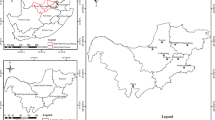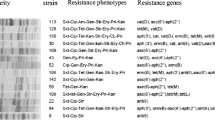Abstract
Vancomycin-resistant Enterococcus faecium (VRE) from human wastewater effluents in a nonclinical semiclosed agri-food system in Texas were characterized for susceptibility to antibiotics and disinfectants. The 50 VRE were resistant to eight fluoroquinolones and 10 of 17 antimicrobials typically active against Gram-positive organisms. The VRE were susceptible to quinupristin/dalfopristin and linezolid. Lack of the insertion element IS1251 correlated with VRE susceptibility to streptomycin and gentamicin at p < 0.0001 and p = 0.033, respectively. An association was observed between pulsed-field gel electrophoresis genotypes Ic and II and susceptibility to streptomycin at p = 0.0006. VRE susceptibility for nine disinfectants and five disinfectant components is shown. Ninety-two percent of the isolates had a minimum inhibitory concentration (MIC) for triclosan ≥2 ppm. Triclosan MICs for many of the VRE were well over expected product application levels. No association was observed between antibiotic resistance and disinfectant susceptibility in these VRE. Enterococci multiply-resistant to vancomycin and aminoglycosides were found in a non-hospital environment where one would not expect to find them.
Similar content being viewed by others
References
Andrews JM (2001) Determination of minimum inhibitory concentrations. J Antimicrob Chemother 48(Suppl S1):5–16
Arthur M, Depardieu F, Molinas C, Reynolds P, Courvalin P (1995) The vanZ gene of Tn1546 from Enterococcus faecium BM4147 confers resistance to teicoplanin. Gene 154:87–92
Bamber AI, Neal TJ (1999) An assessment of triclosan susceptibility in methicillin-resistant and methicillin-sensitive Staphylococcus aureus. J Hosp Infect 41:107–109
Beier RC, Bischoff KM, Poole TL (2004) Disinfectants (biocides) used in animal production: antimicrobial resistance considerations. In: Beier RC, Pillai SD, Phillips TD, Ziprin RL (eds) Preharvest and postharvest food safety: contemporary issues and future directions. Blackwell Publishing Professional, Ames, pp 227–238
Beier RC, Bischoff KM, Ziprin RL, Poole TL, Nisbet DJ (2005) Chlorhexidine susceptibility, virulence factors, and antibiotic resistance of beta-hemolytic Escherichia coli isolated from neonatal swine with diarrhea. Bull Environ Contam Toxicol 75:835–844
Boethling RS (1984) Environmental fate and toxicity in wastewater treatment of quaternary ammonium surfactants. Water Res 18:1061–1076
Bonten MJM, Willems R, Weinstein RA (2001) Vancomycin-resistant enterococci: why are they here, and where do they come from? Lancet Infect Dis 1:314–325
Calfee DP, Giannetta ET, Durbin LJ, Germanson TP, Farr BM (2003) Control of endemic vancomycin-resistant Enterococcus among inpatients at a university hospital. Clin Infect Dis 37:326–332
Cetinkaya Y, Falk P, Mayhall CG (2000) Vancomycin-resistant enterococci. Clin Microbiol Rev 13:686–707
CLSI (Clinical and Laboratory Standards Institute) (formerly NCCLS) (2002) Performance standards for antimicrobial disk and dilution susceptibility tests for bacteria isolated from animals. Approved standard—2nd edn. CLSI document M31-A2. CLSI, Wayne, PA
CLSI (Clinical and Laboratory Standards Institute) (formerly NCCLS) (2005) Performance standards for antimicrobial susceptibility testing; fifteenth informational supplement. CLSI document M100-S15. CLSI, Wayne, PA
Corrier DE, Nisbet DJ, Scanlan CM, Hollister AG, Deloach JR (1995) Control of Salmonella typhimurium colonization in broiler chicks with a continuous-flow characterized mixed culture of cecal bacteria. Poult Sci 74:916–924
Handwerger S, Skoble J, Discotto LF, Pucci MJ (1995) Heterogeneity of the vanA gene cluster in clinical isolates of enterococci from the northeastern United States. Antimicrob Agents Chemother 39:362–368
Matsushima H, Sakurai N (1984) A selected ion monitoring assay for chlorhexidine in medical waste water. Biomed Mass Spectrom 11:203–206
Núñez O, Moyano E, Galceran MT (2004) Determination of quaternary ammonium biocides by liquid chromatography-mass spectrometry. J Chromatogr A 1058:89–95
Poole TL, Hume ME, Campbell LD, Scott HM, Alali WQ, Harvey RB (2005) Vancomycin-resistant Enterococcus faecium strains isolated from community wastewater from a semiclosed agri-food system in Texas. Antimicrob Agents Chemother 49:4382–4385
Prada D, Mezcua M, Gómez MJ, Cerda V, Ferrer I, Farre F, Townshend A, Aguera A, Hernando MD, Fernández-Alba AR (2004) Evidence of 2,7/2,8-dibenzodichloro-p-dioxin as a photodegradation product of triclosan in water and wastewater samples. Anal Chim Acta 524:241–247
Scott HM, Campbell LD, Harvey RB, Bischoff KM, Alali WQ, Barling KS, Anderson RC (2005) Patterns of antimicrobial resistance among commensal Escherichia coli isolated from integrated multi-site housing and worker cohorts of humans and swine. Foodborne Pathog Dis 2:24–37
Sidhu MS, Sørum H, Holck A (2002) Resistance to quaternary ammonium compounds in food-related bacteria. Microb Drug Resist 8:393–399
Sprague LA, Battaglin WA (2005) Wastewater chemicals in Colorado’s streams and ground water. U.S. Geological survey fact sheet 2004–3127
Suller MTE, Russell AD (1999) Antibiotic and biocide resistance in methicillin-resistant Staphylococcus aureus and vancomycin-resistant enterococcus. J Hosp Infect 43:281–291
Acknowledgments
We thank Albert Blanks, Jackie Kotzur, and M. Reiley Street for technical support. The samples were provided through USDA-ARS Cooperative Agreement No. 58-6202-2-022 and USDA-CSREES-NRICGP section 32.1 grant No. 2003-35212-13298. Mention of trade names, proprietary products, or specific equipment is solely for the purpose of providing specific information and does not constitute a guarantee, warranty or endorsement by the U.S. Department of Agriculture and does not imply its approval to the exclusion of other products that may be suitable.
Author information
Authors and Affiliations
Corresponding author
Rights and permissions
About this article
Cite this article
Beier, R.C., Duke, S.E., Ziprin, R.L. et al. Antibiotic and Disinfectant Susceptibility Profiles of Vancomycin-Resistant Enterococcus faecium (VRE) Isolated from Community Wastewater in Texas. Bull Environ Contam Toxicol 80, 188–194 (2008). https://doi.org/10.1007/s00128-007-9342-0
Received:
Accepted:
Published:
Issue Date:
DOI: https://doi.org/10.1007/s00128-007-9342-0




